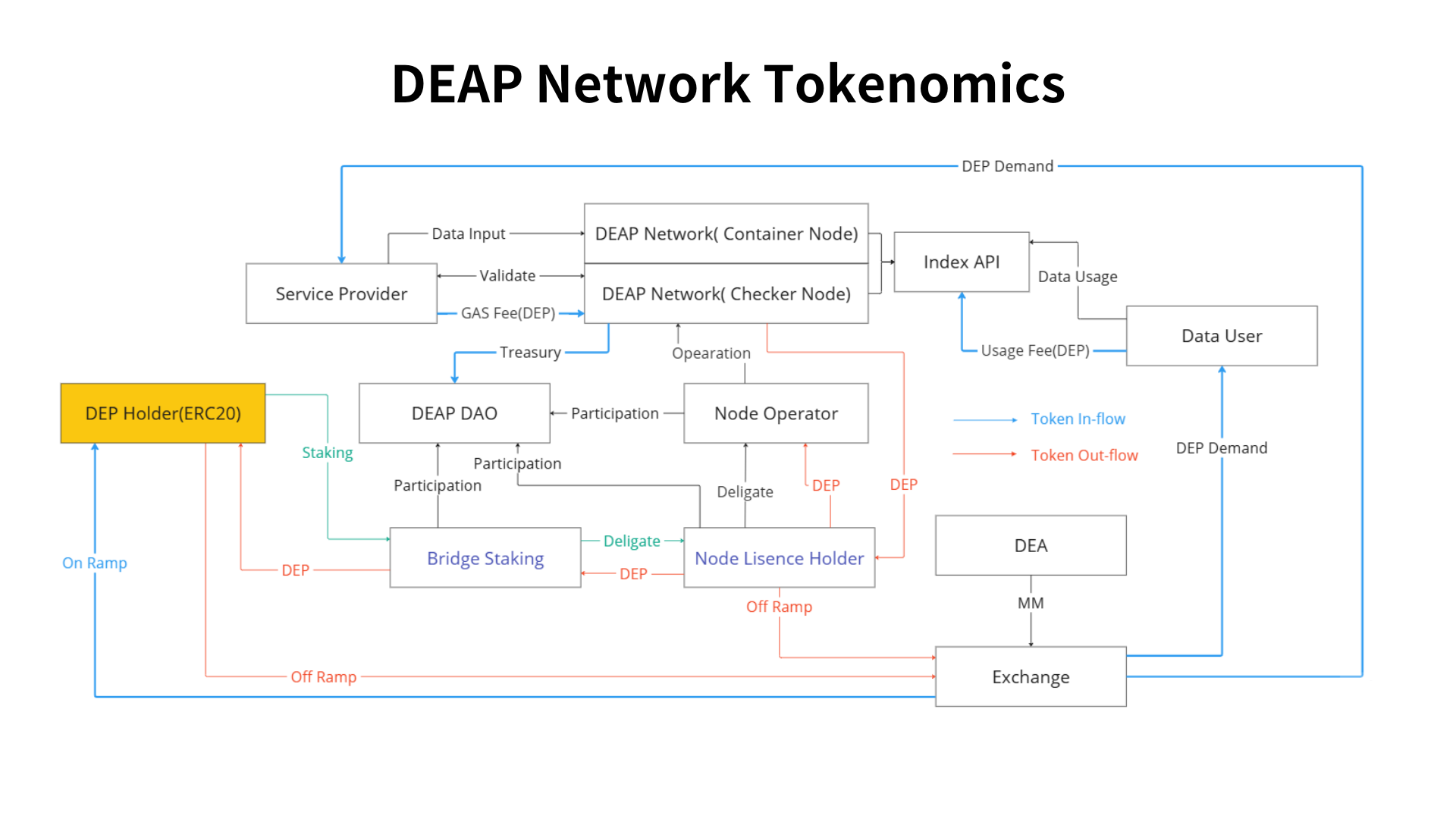
Terminology: Bridge Staking
Bridge staking refers to the mechanism in which DEP tokens—already issued on Ethereum—are locked to simultaneously enable participation in the DEAP Network's validation process. This allows token holders to receive validator rewards without needing to migrate their tokens to the new chain.
Terminology: Node License Model
To operate validators on the new chain, obtaining a node license is required. This measure is essential for maintaining decentralization and ensuring the quality of validators. Users who hold node licenses (hereafter “licensers”) automatically receive delegated DEP from bridge staking, allowing them to function as validators and earn rewards.
Ecosystem Inflow
1. Purchase of Node Licenses
Investors and infrastructure providers purchase node licenses by paying in DEP, stablecoins, or fiat currency. This capital serves as initial funding and is allocated for development, operations, marketing, and the ecosystem fund.
2. Locking of DEP through Bridge Staking
DEP holders on Ethereum lock their tokens in a bridge to participate (or delegate) as validators on the new chain. This process enhances the security of the new chain and stimulates DEP demand by reducing sell pressure as tokens are locked, attracting investor funds seeking staking rewards.
3. Transaction Fees & Data Utilization Fees
Ongoing funds flow into the network through regular transaction fees (gas fees) and fees for using data provided by the DEAP Network (e.g., access fees for activity data or analytics fees).
Ecosystem Outflow
Payment of Validator Rewards
Validators who successfully generate blocks and verify transactions on the new chain earn staking rewards and a portion of gas fees. Users holding node licenses, by consolidating the DEP delegated to them, receive rewards proportional to the performance of the validators.
Redistribution to Bridge Stakers
DEP holders participating in bridge staking receive rewards based on the amount of tokens they have locked. A certain percentage of the validator rewards earned by node license holders is allocated to stakers. In this model, operator fees are deducted by licensers, and the remainder is distributed to stakers.
Ecosystem Fund & Operational Expenses
A portion of the funds from node license purchases and transaction fees is pooled into the ecosystem fund. These funds are used for various expenditures, including development grants, marketing, and governance rewards. Additional outflows may be allocated as rewards for the operations team and community contributors, as needed.
Balancing Inflow and Outflow
1. Limiting the Number of Node Licenses
By capping the issuance of node licenses, the uncontrolled proliferation of validator nodes is prevented. This ensures that the number of operating nodes and the stake allocated to each node remain balanced.
2. Adjusting the Staking Reward Rate
The network’s inflation design and reward rate will be periodically reviewed and adjusted through governance voting. Excessively high rewards could devalue the token, while rewards that are too low might discourage node operators. The community must reach a consensus to determine the optimal reward rate.
3. Operation Fees for Node License Holders
Node license holders, in exchange for accepting bridge staking responsibilities, incur an operational fee (e.g., 5–10%). While stakers benefit from earning validator rewards without operational burdens, licensers bear the costs of server maintenance and technical support. (These costs can alternatively be re-delegated to operators.)
4. Circulation of Data Utilization and Transaction Fees
Fees paid by network users serve as a critical revenue source for validator and staker rewards. As data services and DApps generate new value, fee revenues increase, creating a positive, self-sustaining cycle within the ecosystem’s tokenomics.
$DEAPcoin
[DEAPcoin(DEP)]
DEAPcoin (DEP) is an ERC-20 utility token issued to users on the PlayMining platform, with a maximum issue of 30,000,000,000.
- Token contract address: 0x1a3496c18d558bd9c6c8f609e1b129f67ab08163
